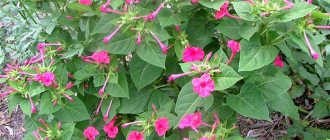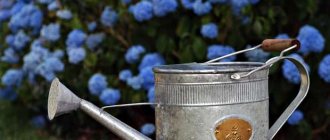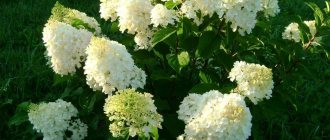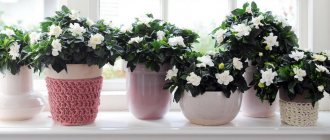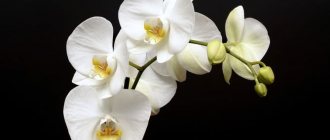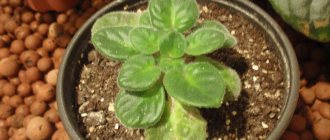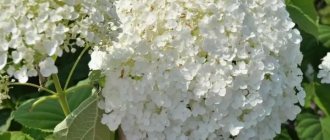Author: Elena N. https://floristics.info/ru/index.php?option=com_contact&view=contact&id=19 Category: Garden plants Published: February 18, 2019Last edits: January 13, 2021
When the days become noticeably shorter and the air smells of frost, it means it’s time to prepare your garden shrubs for winter. The responsibility of this event can hardly be overestimated: not only their flowering next season, but also their overall health depends on how you prune and cover your ornamental shrubs. In our climate, three types of hydrangea are usually cultivated: paniculate, tree-like and large-leaved. And each of them requires a special approach. From our article you will learn:
- how to prune each variety of hydrangea in the fall;
- how to prepare them for winter;
- how to protect them from winter frosts.
Listen to the article
Hydrangea (lat. Hydrangea) are flowering plants of the Hydrangeaceae family, of which in nature, according to various sources, there are from 30 to 80 species. Among them are shrubs and small trees, growing mostly in East and South Asia, China, Japan, the Far East, and the Americas. The plant was named after Princess Hydrangea, whom no one remembers for a long time; later, when botanists were engaged in systematizing plants, hydrangea received the Greek name Hydrangea, which translates as “vessel with water” - the shape of the plant’s seed pods resembles a jug, and the plant itself is very loves water.
The Japanese call hydrangea "ajisai", which means "purple sun flower". It was from Japan that hydrangea was brought to Europe in 1820, and at first it was grown only as a houseplant due to its low winter hardiness, but breeders were so keen on cultivating hydrangea that by the middle of the 20th century more than 100 garden varieties were created. In our latitudes, garden hydrangea is represented quite widely - twelve popular species.
Common mistakes
- Hydrangea is not pruned. All varieties of hydrangea require pruning to one degree or another. This is an important part of autumn shrub care.
- Hydrangea does not hide. In the conditions of the Middle Zone and especially the Urals and Siberia, the crop must be insulated for the winter from frost.
- The plant remains without water in the fall. During half of autumn, hydrangea needs regular watering. You cannot leave the plant without water immediately after flowering.
- Incorrect feeding. Autumn care is feeding with potassium and phosphorus compounds. Nitrogen and most organic matter cannot be used.
- There is no treatment for diseases. Hydrangea and the soil under it must be sprayed with fungicides.
- Incorrect trimming. The degree of pruning depends on the type of shrub. Some require only careful pinching of the crown and sanitary thinning.
- There are no ventilation holes in the covering structure. In any case, it is necessary to ensure access of air to the shoots of the plant so that they do not begin to rot.
Botanical description
Most of the hydrangea species are shrubs with a height of 1 m to 3 m; among hydrangeas there are both trees and vines that climb tree trunks to a height of up to 30 m. Among the representatives of the genus there are evergreen species, and there are deciduous ones, but in our latitudes they are grown namely the latter, blooming from spring to late autumn. Two types of flowers are collected in spherical inflorescences at the ends of the stems - sterile at the edges and fertile in the middle of the inflorescence. The flowers are most often white, but a species such as large-leaved hydrangea is represented by varieties with pink, blue, lilac and red flowers, and the acidity of the soil determines the color of the specimen. For example, hydrangeas with blue flowers grow in acidic soil, lilac and pink flowers in alkaline soil, and soft beige flowers in neutral soil. The fruit of hydrangea is a multipartite capsule with seeds.
- Tigridia: cultivation and care in the garden, types and varieties
In addition to large-leaved hydrangea, tree hydrangea grows well in our climate, known for its winter hardiness and ability to recover well from severe frosts. Paniculata hydrangea also overwinters well, known for its longevity - it can grow in one place for up to 60 years.
In addition to these three most popular species, such species as serrate hydrangea, serrate hydrangea, climbing hydrangea, radiant hydrangea, Sargent hydrangea, petiolate hydrangea, oakleaf hydrangea and others are known in floriculture.
Feeding hydrangeas in autumn
The moment of feeding perennials before winter is important. To strengthen the root system, as well as the ripening of shoots, potassium and phosphorus fertilizers are used.
Fertilizers are applied before pruning. It is recommended to use granular fertilizer. It is scattered in a circle around the trunk and then embedded in the soil. If the autumn is rainy, the fertilizer decomposes from the rain. If the weather is dry, then it is worth watering the bushes.
The consumption rate of the preparations is 15 g of potassium monophosphate and 15 g of superphosphate per 1 sq. meter of trunk circle, or 40 grams of each drug per bush.
IMPORTANT! In the fall, it is highly recommended not to apply organic fertilizers. It is also undesirable to use fertilizers high in boron, magnesium and iron.
It is permissible to use only wood ash from organic matter (2 cups for each bush).
A special feature of hydrangea is that you can change the color of the inflorescences by applying different fertilizers. Including in the fall.
For example, by mulching the surface with pine needles and acidic peat, you can give the inflorescences a blue and blue tint.
Pruning hydrangeas after flowering
Caring for hydrangea involves, among other things, pruning it. Some amateur gardeners claim that hydrangea is like lilac - the more you prune, the more luxuriantly it blooms the next year. This is not entirely true, since this statement is true for paniculate and tree hydrangeas, but colored (large-leaved) hydrangeas cannot be pruned. Large-leaved hydrangea blooms on last year's shoots, so young branches that grew this summer must overwinter, and only next year they can bloom.
As for the species with white flowers, namely paniculate and tree hydrangeas, they bloom on annual stems, so after pruning, as stated, they will have many young shoots that will produce more flowers. It is recommended to prune hydrangeas in the spring, but this must be done carefully, since sap ferments in the plants, and they “cry” when pruned. Many gardeners believe that it is better to prune hydrangeas in the fall.
Based on these differences between species, hydrangeas were divided into two groups based on pruning quality. The first group includes species that bloom on last year's shoots, such as the already mentioned large-leaved hydrangea, as well as serrated, prickly, Sargent, oak-leaved and petiolate liana-shaped hydrangeas. Pruning of these hydrangeas can only be cosmetic, removing last year's inflorescences down to the first pair of strong buds and weak, old shoots completely.
The second group includes species in which buds form on the shoots of the current year: paniculate hydrangea and tree hydrangea. The main pruning of these types of hydrangeas is usually done in the spring, before the start of the growing season. Tree hydrangea is subjected to the procedure only if it is already four years old, otherwise it may die, bleeding juice. However, if you prune in the fall, this problem will not happen. An adult, and especially an old plant that needs to be rejuvenated, is cut “to the stump”, that is, only 10 cm are left from each shoot.
- Cossack juniper: planting and care, description of varieties
If the bush is too large and old, there is no need to prune it at once, otherwise the short shoots will not be able to feed the large root mass. Rejuvenate the bush in parts over three years.
Paniculate hydrangea is pruned sparingly, like a tree, without touching the skeletal branches: of the several shoots that grow from one point, only those that grow outward are left.
Pruning hydrangeas in the fall is absolutely safe and will ensure your plant blooms luxuriously next year. In hydrangea species of the second group, the inflorescences are cut off so that the fragile branches of the plants do not break under the weight of the snow that sticks to them in winter - this is the case if you do not intend to cover the hydrangea for the winter. In addition, old thick stems are removed from tree hydrangea, and weak thin shoots from paniculata hydrangea, and annual growth is shortened by 2-5 buds.
Treatment of hydrangea in autumn
Hydrangea is not one of the most disease-prone garden crops. However, it should also be treated in the fall as part of sanitary measures in preparation for winter.
Spray hydrangea on bare branches. They also cultivate the soil under each bush.
Among the drugs against fungal, bacterial and viral infections, Bordeaux mixture (1%) or Abiga-Pik (40 ml per bucket of water) is used.
Aktara helps well against pests.
Preparing hydrangea for winter
Caring for paniculata hydrangea in the fall (and other species too), on the eve of the onset of cold weather, involves covering the hydrangea for the winter. Unfortunately, not a single type of hydrangea can winter in our area without insulation, so preparing garden hydrangeas for winter must be thorough. The tree hydrangea is the most winter-hardy, but it also needs shelter for the winter, otherwise the ends of its young shoots may freeze.
Start preparing in mid-September: remove all leaves except the top ones in order to speed up the process of lignification of the shoots, and feed the plants with phosphorus-potassium fertilizers (hydrangea is not fertilized with nitrogen in the fall). Now you can cover the hydrangea.
Treatment against diseases and pests
The flowering of a diseased plant becomes scarce. To protect hydrangea from diseases and pests, preventive treatment is carried out in the fall. For spraying, use 3% Bordeaux mixture.
The composition is quite toxic; when working with it, wear a respirator, safety glasses, and closed clothing. After spraying the bush, the remaining solution is poured into the tree trunk area. Pests and their larvae often hide in the top layer of soil for the winter.
How to cover a hydrangea for the winter
There are several methods of shelter, but it all depends on what kind of winters are in your area. In the southern regions, it is often enough to simply hill up a bush of tree or paniculate hydrangea high. If your winters are unpredictable, then it is better to play it safe and still cover your hydrangeas. Small plants can be completely covered with peat and covered with a film on top - don’t be afraid that the plant may get wet, this probably won’t happen.
A well-proven method allows you to cover a small young plant without causing harm to it: tie a rope around the bush and pull it slowly, without jerking, to boards laid on the ground with nails driven in, to which you tie the plant. Then cover it with spruce branches or sawdust, and cover it with a sheet of old iron, lutrasil grade 30 or spunbond.
- Sedum: growing from seeds, types and varieties
Another method: the trunk circle is covered with spruce branches, the hydrangea shoots are bent to the ground radially, away from the center of the bush, the bases of the laid shoots are secured with brackets made of wood or metal and the center of the bush is covered with peat, spruce spruce branches are laid on top of the lying shoots, which is covered with lutrasil. Lutrasil needs to be pressed down with boards and bricks to prevent it from being blown away by the wind. This hydrangea shelter can withstand temperatures of -40 ºC.
It will be difficult to bend old powerful bushes to the ground, so the following method of covering them for the winter is provided: the bush is wrapped in lutrasil, which is fixed with twine or tape, then a metal mesh frame is installed above the bush, which should be 12-15 cm higher than the covered plant Large quantities of dry leaves are placed inside the frame, and the structure is covered with roofing felt or plastic film on top.
Every year, the winter hardiness of hydrangea increases, and over time you can refuse to cover adult bushes, but young plants should be covered in any case in the first years of their life, even if the winter turns out to be warm.
Covering large-leaved hydrangea is carried out gradually
- You need to start by mulching the base of the bush. Peat, pine litter or even fallen oak leaves are perfect for this, because they do not rot.
- Also, be sure to remove both drying and green foliage from the shoots, since under cover it can begin to rot and harm the bush.
- If the bush is young, loosely tie the shoots together, and if the hydrangea is already quite thick, then combine 4-5 branches to tie them together. It is not recommended to use synthetics and it is better to tie them with some soft material so as not to damage the shoots.
- The tied bundles are bent to the ground very carefully, slowly, to eliminate the possibility of damage.
- When the connected shoots are already at ground level, fix the bunches. For example, metal staples are suitable for this.
- While night temperatures are above zero, wrap the resulting structure with covering material.
- When cold weather sets in, add peat or dry leaves over the covering material. Moreover, attention should be paid to the shoots from the middle to the tips, because we have already hilled up the lignified bases a little and this will be quite enough for them.
- Finally, you should install the arches or any other frame and cover it with covering material.
Under such a warm “blanket” your large-leaved hydrangea will survive well until spring, even if the winter is quite frosty, but not very snowy.
Features of training in different regions
A heat-loving crop like hydrangea needs to be prepared for wintering in almost any region of Russia . The list of items required for insulation may change slightly. For example, in the southern regions it will be enough to stop watering and autumn feeding, without constructing shelters. And in the Moscow region or in the Urals, it is imperative to carry out work on additional insulation of the above-ground and underground parts of the bush.
Also learn about transplanting hydrangeas in the fall and caring for them.
In outskirts of Moscow
In the Moscow region, winters can be extremely frosty, so owners of potted hydrangeas should bring them into rooms with zero temperature . The root part of the plants in the flowerbed must be insulated with pine bark or sawdust. If possible, tilt the above-ground part and fix it on the ground, then cover it with insulating material that allows air to pass in both directions.
If a place protected from cold northern winds by the wall of a house or other building was used to plant a bush in the Moscow region, insulating the stems without laying them on the soil will be sufficient.
Video: Shelter of large-leaved hydrangea in the Moscow region
In the Urals
The region is known for its harsh and long winters, when temperatures can drop below -40°C. In the Urals it is difficult to preserve hydrangea during the winter without additional shelter. Varieties whose shoots are not cut close to the soil should be carefully bent towards the ground so that 2/3 of the length of the stems lies on the ground. To fix them, oppression (bricks, boards) is placed on top. Next, pour a small mound of mulch on top of the tree trunk circle. And only after this is it worth covering the above-ground part of the bush with several layers of agrotextile.
We recommend reading suitable varieties and secrets of growing hydrangea in the Urals.
In the Leningrad region
Heavy winter rainfall in this area allows garden owners to neglect insulation for hardy varieties of hydrangea, such as bush hydrangea. High snowdrifts will protect the plant well from frost . For more delicate species, it will be enough to cover the soil with a thick layer of mulch, and the above-ground part with spunbond. There is no need to lay branches on the soil.
Gardening Tips and Tricks
In order to enjoy the beauty and splendor of hydrangea blooms in the summer, it is useful to learn a few tricks for caring for them in the fall.
- When replanting a plant, you should choose a sufficiently lit place for it. However, at midday, when the sun's rays are at their brightest, the area should be slightly shaded.
- You can restore the acid-base balance of the soil not only with expensive fertilizers. Citric acid is an excellent and inexpensive way to acidify the soil.
- The soil in which the bush has grown for several years becomes depleted and becomes less fertile. Therefore, for excellent flowering of hydrangea after transplantation, it is best to rinse its roots in water, and only then place it in new soil.
About the species and their frost resistance
Amateur gardeners and professional landscape designers prefer 10-12 varieties because they are the most attractive, relatively unpretentious and affordable. However, the degree of frost resistance is very different: some varieties come from southern latitudes, others from northern latitudes. The approach to preparation will vary.
Hydrangea
The most common plant. It is a large shrub. Very quickly it acquires dimensions of up to 2 meters. The flowers are large, spherical, about 30 cm in diameter. Flowering continues until the end of November. Tree varieties need to be prepared for wintering as cold weather sets in. The type is quite frost-resistant, so in middle temperate latitudes you can leave everything as it is. The shrub can withstand temperatures down to -15-20°C. It makes sense to cover the lower parts of the bush so that the roots do not freeze. In Siberia and the Urals, the plant is completely covered because winters are too unpredictable.
Paniculata
Even more unpretentious. It got its name from the characteristic shape of the flowers. They are cone-shaped and look like large panicles up to 20 cm in the widest part, at the bottom. Some flowers are small, they are responsible for reproduction.
The paniculate type can withstand cold temperatures up to 35-40 °C. Therefore, without much risk, this garden crop can be left without shelter even in harsh weather regions with an early onset of winter. There are more than a dozen varieties. They all have a different appearance, but are approximately equivalent in terms of care and preparation for the cold season.
large-leaved
Hydrangea broadleaf is a very large shrub. Some varieties reach 4 meters in height. It comes from the south, therefore it is very capricious and requires careful shelter for the winter. Without insulation, the entire bush will freeze to the ground. This means you can’t expect flowering in the next few years.
The difficulties, however, are more than offset by the results. Large-leaved varieties produce large, fragrant flowers in a variety of colors. This is an excellent garden decoration.
Ashy
Something average in terms of frost resistance. It is a small bush up to 2 meters in height. In temperate latitudes at temperatures above -5-7 degrees it feels quite comfortable even without special shelter. But it is impossible to predict the course of winter. Therefore, it is worth taking care to create comfortable conditions. Otherwise, the ash variety is unpretentious and suitable for beginner gardeners.
Oakleaf
A very capricious plant. Two-meter shrub with large flowers. It changes appearance closer to autumn, acquiring characteristic purple shades. It got its name for the characteristic appearance of its leaves. They are large and dense, with a serrated pattern. Due to this they resemble oak leaves.
Needs to be covered for the winter. Otherwise, it will freeze to the roots and die.
Rough
The shrub is more than 2-3 meters in height with large flowers, with a diameter of 25 to 30 cm. Like the oakleaf hydrangea, the rough one requires careful shelter for the winter.
Chereshkova
Liana-like plant. Due to its attractive appearance, it is widely used in landscape design as a decoration for hedges and walls. Unpretentious, suitable for young gardeners. However, it has average frost resistance. At temperatures below -10, it requires shelter for the winter. You should not neglect preparation. Culture develops very slowly. If the shoots die, you can wait several years for a new flowering.
Bretschneider
Unpretentious varieties. The plant is highly resistant to cold and is not demanding in terms of nutrition, watering, or soil type. It looks like a large bush up to 4 meters in height with large white or pinkish flowers. It gains strength relatively slowly and does not bloom for so long: from July to mid-autumn and even less.
Serrated
Another type comes from the south. Small bush up to 2 meters. A distinctive feature is the ability to bloom several times a year without additional tricks, fertilizing or harm to the crop itself.
It is absolutely not suitable for the northern regions, since it does not tolerate cold weather. We will have to seriously worry about preparing for the winter season. The ornamental plant has a very attractive appearance: unusual flower shapes are combined with soft pinkish or deep blue shades.
Hortensia Sargent
Not a cold-resistant variety. Requires shelter for the cold season.
Ground cover
Shrub with dense stems. It is actively used in landscape design due to its ability to hold its shape. The bush can be pruned to give it the desired look. This opens up additional possibilities for creating decor.
Needs to be covered for the winter.
Radiant
A small variety. Frost resistance is low, but this feature is compensated by survivability. Even with total freezing to the soil level, the bush recovers very quickly. It makes sense to cover the roots and lower shoots of the plant so that flowering begins earlier in the next season.
Varieties differ in the characteristics of care, the difficulty of preparing for winter and other factors.
general information
There are many species and subspecies of hydrangea, or as it is also called - hydrangia. There are tree-like, large-leaved, paniculate and ampelous plant varieties, as well as indoor and garden varieties. They differ in the size of the bush, leaves and inflorescences, their shape, color and other cultural characteristics.
Ampelous hydrangea “Runaway Bride” is a new hybrid that tends to form several inflorescences on a branch, and not just on the tops, like other types of plants. Tree and paniculata bloom on new shoots, so they are not afraid of frost. In large-leaved or garden hydrangea, cold can destroy flower buds on last year's shoots and they will no longer bloom.
Pink and blue varieties of hydrangia have a unique feature - the flowers change color, depending on the acidity of the soil when grown:
- Sour – blue and purple tints will predominate.
- Alkaline - purple and pinkish.
- Neutral - the flowers will turn white. This is a type of large-leaved hydrangea that should be properly pruned and covered for the winter.
Indoor varieties are deciduous perennials, which still shed their leaves in winter and go into a dormant period. It is necessary to prepare them for wintering and place them in cooler conditions.
Nuances of caring for hydrangea in Siberia
Despite severe frosts and not very hot summers, hydrangeas grow well in Siberia and bloom wonderfully there. Are all varieties suitable for growing? No. The best choice is 20 varieties of paniculate variety. Well proven: Pink Diamond and Magical Fire. Dwarf varieties winter well in such harsh conditions.
A correctly selected variety will illuminate the Siberian garden with large hydrangea inflorescences
If you decide to grow large-leaved varieties, then get ready to dig up the bush every fall and bring it into the cellar so that you can plant it in the garden again in the spring. If in other regions you can plant hydrangea in the fall, then in Siberia planting is carried out only in the spring. Otherwise, caring for the beauty is the same as in other regions: four feedings per season, abundant watering, mulching and high-quality insulation for the winter.
What to do in spring with covered Hydrangea
With the arrival of warmth, the bushes must be opened gradually. When the snow melts, first remove the plastic film to prevent condensation from forming. Do not rush to remove hay, leaves or spruce branches. If spring frosts come, cover your bush with foil overnight. When the risk of new frosts has passed, open your shrub and remove all insulation. At the same time, it is worth applying complex fertilizers and watering well.
For quality preparation for wintering, Hydrangea will generously thank you with abundant and spectacular flowering.
Wintering
Petiolate hydrangea is a frost-resistant plant that can withstand even harsh winters. But it is recommended to remove young seedlings from their support within 2-3 years and make a light shelter in case of a snowless, frosty winter. An adult plant easily recovers after freezing, continuing to develop and bloom well in the future, so there is no need to remove it from its support.
Due to its winter hardiness, this crop is grown in the Moscow region and even in Siberia. That is why domestic gardeners and designers are increasingly using petiole hydrangea today to decorate their garden plots.
